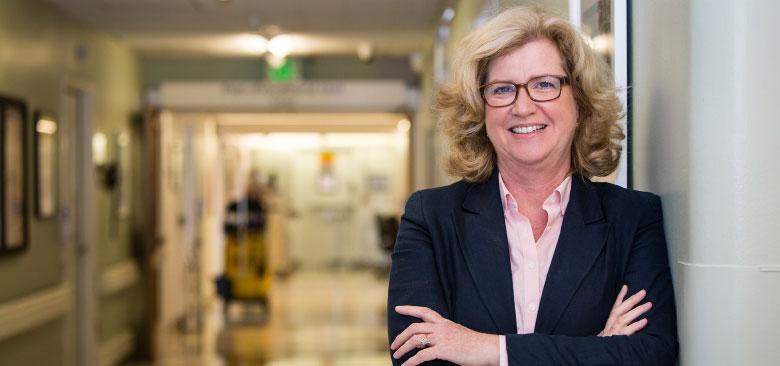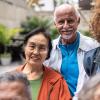
Kimberly Pyke-Grimm (photo by Elisabeth Fall)
How Can Adolescents and Young Adults with Cancer Make Treatment Decisions?
In 2007, then-Governor Tim Kaine of Virginia signed a bill that allowed children over age 14, with the support of their parents or guardians, to forgo medical treatment or seek alternative treatment for serious health conditions. While opinions on the law remain sharply divided, it does highlight a need for greater understanding of how and why adolescents and young adults make crucial decisions regarding their medical treatment.
That’s the aim of Kimberly Pyke-Grimm’s research. Pyke-Grimm is a PhD candidate at UC San Francisco School of Nursing. Her work builds on 27 years of experience as a pediatric oncology clinical nurse specialist. When she was caring for patients and families enrolled in clinical trials that tested cancer treatments for children and adolescents, she bore witness to families struggling to make difficult treatment decisions.
Helping Children and Families Confront Cancer
In 1991, after completing a master’s degree in nursing at UCLA, Pyke-Grimm returned to her native Canada to work with Lesley Degner at the University of Manitoba College of Nursing. Degner’s work examines treatment decision making in adults with cancer, and in her eight years there, Pyke-Grimm and other colleagues published a series of papers on how parents of children with cancer make treatment decisions.
The work cultivated a passion for research, which Pyke-Grimm mostly set aside while raising her own three children. But, she says, “As my children got older, I thought, ‘Now’s the time to do it.’”
Disparities in Cancer Research and Outcomes
“It” was pursuing her PhD. With the support of her dissertation committee (UCSF’s Roberta Rehm, Linda Franck and Robert Goldsby and Stanford’s Bonnie Halpern-Felsher), Pyke-Grimm zeroed in on the topic of treatment decision making for adolescents and young adults with cancer. The age group, considered to be individuals between 15 and 39, is understudied and underrepresented in clinical trials, for reasons that include a lack of age- and diagnosis-specific trials, reduced access to care and what the National Cancer Institute calls the lack of “a robust community oncology and primary care infrastructure.”
The failure of the health care system to connect with this age group has had real consequences in terms of outcomes. “Survival rates [in this group] have improved only minimally over the past decade,” Pyke-Grimm says. Underrepresentation in clinical trials may be one reason, but there are others, including nonadherence to cancer treatment, which can be as high as 63 percent among adolescents and young adults
She adds that the participants in her study occupy a sort of “no-man’s-land” in the medical world, because their emotional and physiological needs straddle the line between children and adults. The underrepresentation in the studies means there is not enough understanding among clinicians of the developmental and biological differences between young children, adolescents and young adults on the one hand and older adults on the other. There’s not always consensus on where to place them for treatment. In one hospital, a 21-year-old may be on the pediatric ward, while in another, a 17-year-old may be treated alongside older adults.
Pyke-Grimm believes that supporting patient- and family-centered care and decision making can help improve the chances for successful treatment in this age group. “We know that open communication and positive family relationships can support treatment adherence,” she says. “But I also want to understand the range of factors that influence adolescent and young adult decision making, so we can do a better job of providing individualized, family-centered care and help guide families through an incredibly difficult time.”
Drilling Down into the Decision-Making Process
To that end, Pyke-Grimm is currently finishing up a focused ethnographic study supported by a Ruth L. Kirschstein National Research Service Award from the National Institutes of Health (NIH)’s National Institute of Nursing Research. She has also received funding from the American Cancer Society and the School’s Graduate Dean’s Health Sciences Fellowship.
A focused ethnographic study is a type of qualitative research in which the researcher gains a deep understanding of the participants’ culture, experience and point of view. It’s especially useful in describing complex phenomena or problems that are not yet clearly defined. Treatment decision making among adolescents and young adults fits that description.
To tease out and describe the issues involved, Pyke-Grimm has been conducting in-depth interviews with patients aged 15 to 25 years who are within a year of a cancer diagnosis and facing important choices about their care, such as what surgery to undergo or whether to enroll in a clinical trial.
“[These young people] are trying to transition to become autonomous adults and learn to make their own decisions, and suddenly, they’re being asked to make decisions that may be life-altering,” says Pyke-Grimm. “I’m exploring what kinds of decisions they do and don’t want to be involved in, and how they interact with their family, especially their parents, to make these decisions.”
In addition to the crucial parent and family dynamics, Pyke-Grimm is exploring how a young person’s attempts to define her- or himself apart from the family affect the decisions. The physical and psychosocial changes related to illness and treatment can accelerate the emotional roller coaster of adolescence and young adulthood.
Even as a young person is learning to function more independently, Pyke-Grimm says, “They’re thrown into this world where they may be bald, they may be losing lots of weight – and they are suddenly dependent again.”
Preparing for a Lifetime’s Work
Pyke-Grimm’s interactions with her study participants have given her an even greater appreciation for the challenges they face as they navigate a cancer diagnosis and treatment. She’s hopeful that her current study – and the others she hopes to conduct down the line – will not only help clinicians better understand how to care for adolescents, young adults and their families, but also empower the young people in their decision making at whatever level of participation they prefer.
It is work she intends to continue, because, she says, “It’s been a real privilege for me to spend time with these [young people] at a difficult time in their lives and to be able to listen and ask questions.… I see this as a lifetime’s work.”



